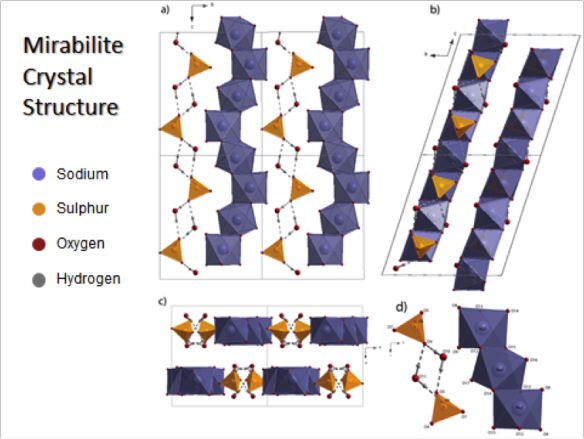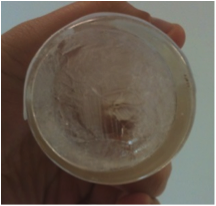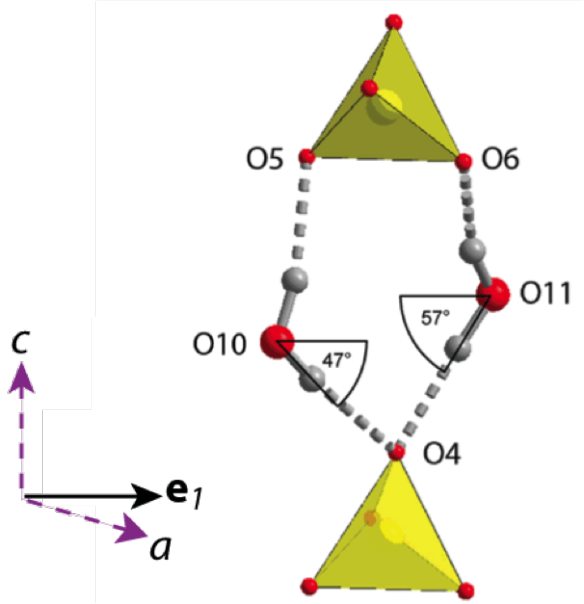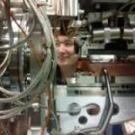Mirabilite: "The Miracle Salt"
Today Dr Helen Brand gives us a perspective on her favourite mineral:
What does it look like?

Figure 1. The structure of mirabilite. This picture was made using the Diamond Visualisation software.
What is it?
Mirabilite: Na2SO4.10H2O
Throw some sodium sulphate into a beaker, leave it on a windowsill for a few days and you will come back to a mass of lumpy crystals (Figure 2).

Figure 2. Synthetic mirabilite.
Possibly my favourite mineral, this is mirabilite. Whilst I love a bit of mirabilite, a lot of people, especially those in the building trade, hate it. Mirabilite is stable to just above room temperature. Imagine it is a sunny day and you have a building stone, now add some rain. Some of the sodium sulphate in the rock is dissolved into the rain water which sits in pores within the rock. As night falls, so does the temperature, and solid mirabilite becomes stable and crystallises in the pore spaces in the rock. Just like ice, the volume of the solid is greater than that of the liquid. For mirabilite, the volume change upon crystallisation is even bigger than for ice. This large volume change puts stress on the building stone and it cracks, weakening any buildings constructed from the stone.
Mirabilite was first synthesised and described by Johann Glauber in 1648, while he was trying to make nitric acid. He called it "sal mirabilis", the miracle salt, for the health benefits it provided as a laxative and because he wasn't expecting to form it as a by-product of his acid-making process. It became known as Glauber's salt and was finally found in nature and the mineral mirabilite named around 1842.
So why do I love mirabilite? Mirabilite is an abundant but elusive mineral, largely thanks to the dehydration temperature being not very far above room temperature. It is found in evaporite deposits here on Earth and is also thought to be a rock forming mineral on the icy satellites of Jupiter. Mirabilite has a fascinating crystal structure; it is a layered structure with chains of sodium octahedra along the c-axis which are separated by sulphate tetrahedra which are connected together through hydrogen bonds. It also contains disorder of the sulphate tetrahedra and the hydrogen bonds attached to the sodium sulphate tetrahedra. These involve atoms "hopping" between possible positions that they can't decide between. The behaviour of this mineral with changes in temperature is controlled by the interaction of two of the hydrogen bonds with the sulphate tetrahedra (Figure 3).

Figure 3. The hydrogen bonds and sulphate tetrahedra which control the behaviour of mirabilite with temperature.
Where did the structure come from?
This structure (Figure 1) was produced by the author's own fair hand from neutron diffraction data obtained at 4.2K at the High Resolution Powder diffraction beamline at the ISIS neutron spallation source, UK. We started with the coordinates determined by Levy and Lisensky's 1967 single-crystal study and refined the structure from there (Brand et al. 2009). The original structure was first determined by Ruben et al. 1961. All these structures are available in the American Mineralogist crystal structure database.
Brand H.E.A., Fortes A.D., Wood I.G., Knight K.S., Vocadlo L. (2009) The thermal expansion and crystal structure of mirabilite (Na2SO4.10D2O) from 4.2–300 K, determined by time-of-flight neutron powder diffraction. Phys. Chem. Min. 36:29–46.
Levy H.A., Lisensky G.C. (1978) Crystal structures of sodium sulphate decahydrate (Glauber’s salt) and sodium tetraborate decahydrate (borax). Redetermination by neutron diffraction. Acta Cryst Sect. B Struct. Sci. 34:3502–3510.
Ruben H.W., Templeton D.H., Rosenstein R.D., Olovsson I. (1961) Crystal structure and entropy of sodium sulfate decahydrate. J. Am. Chem. Soc. 83:820–824.






